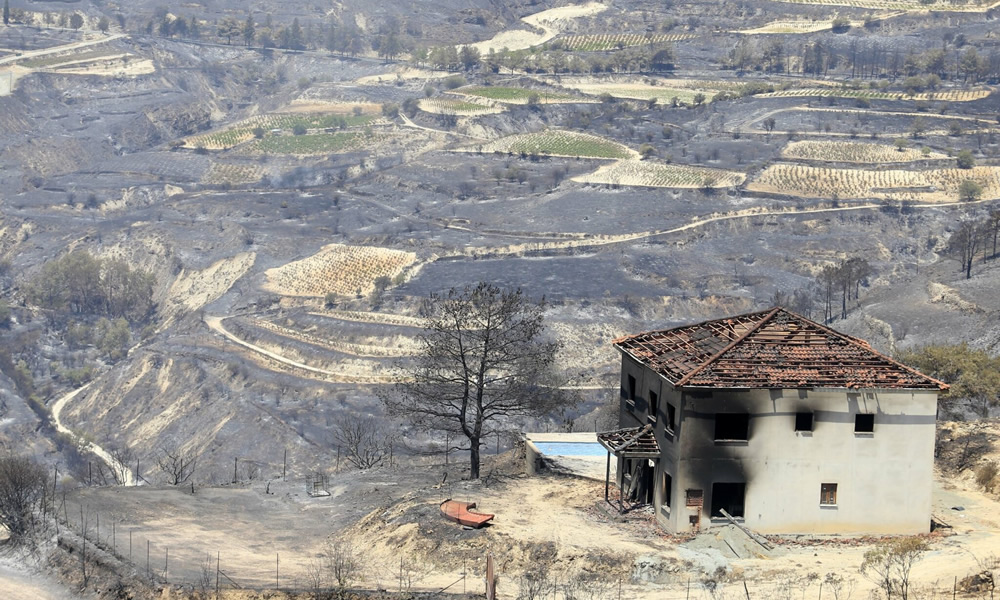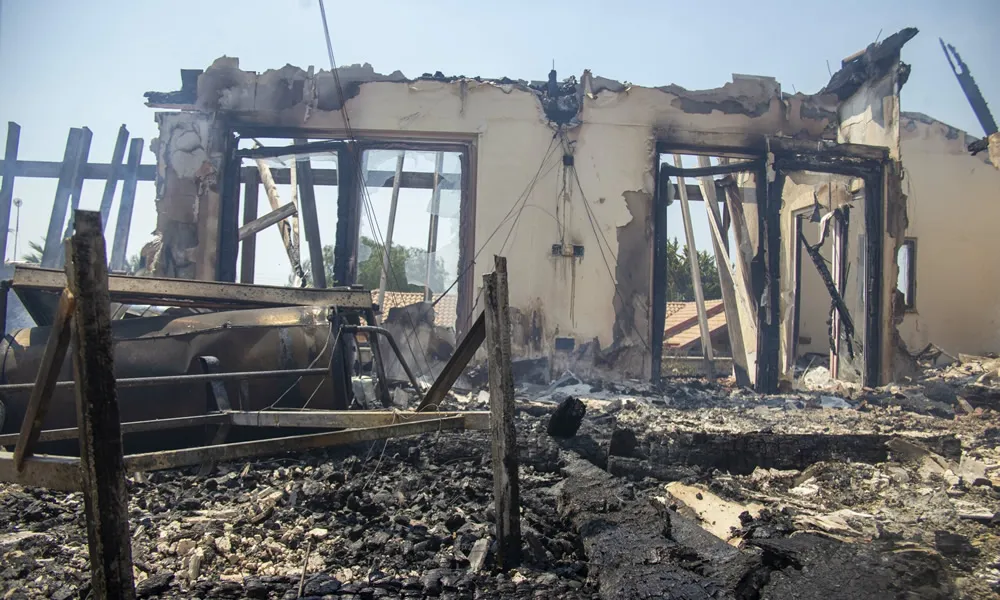More than two months after the devastating wildfire in semi-mountainous Limassol (July 23, 2025), neither the President of the Republic nor the responsible ministers speak anymore of an independent inquiry into how the disaster was managed. President Christodoulides asked for and received four reports from the relevant agencies, the Fire Service, Forestry Department, Civil Defence and Police, which documented events while shielding responsibilities. American experts briefly visited, pointed to “ground zero” and two discarded cigarette butts as the cause, and departed. Officially, everything was said to have worked correctly and responsibly, yet two people still lost their lives (dismissed at first as “an unfortunate incident” by Justice Minister Marios Hartsiotis, who later apologised after public outrage). More than 700 homes and properties were destroyed or damaged, and over 100 square kilometres of land turned to ash. Still, every minister kept his post. They withdrew from public view for a few days to avoid questions and explanations, but in recent weeks have begun reappearing at events, making statements on everything except the issue at hand.
Policy shifts and label changes
The matter of wildfires now seems to have been taken up by the “Prime Minister” Irini Piki (Deputy Minister to the President), who announced after the 17 September 2025 cabinet meeting that the Ministry of Interior is being renamed and converted into the Ministry of Interior and Civil Protection, a decision taken in cabinet without the Interior Minister being present (he was abroad). We were told this was a “general description” that would require time and legislation to implement, but for some reason it had to be announced that day, the eve of the joint House committee session (18/9/2025) on the Limassol wildfire. In addition, Ms Piki announced the creation of a National Civil Protection Mechanism and the transfer of the Fire Service from the Ministry of Justice and Public Order to the Ministry of Interior, along with the transfer of all activities and staff of the Forestry Department that deal with fire protection from the Ministry of Agriculture, Rural Development and Environment to the Ministry of Interior. A National Coordinator post is also being created, appointed by cabinet, with overall responsibility for coordinating all Services transferred to the Interior Ministry, including Civil Defence, on matters of natural and other disasters. The Police remain under the Justice Ministry, the Meteorological Department under Agriculture, and aerial firefighting means under the National Guard.

Forestry Department unsettled
Since the announcement that forest firefighting would be moved to the Ministry of Interior, the Forestry Department has been in turmoil, the entire Department believes that “fragmenting forest management poses a huge threat to the protection of the island’s forests.” Not long ago, changes had already been made in both personnel and structure at the Agriculture Ministry, and before they could even be implemented, new “emblematic reforms” were announced without a clear plan, roadmap or timeline, and without the Fire Service or the Forestry Department even being consulted or briefed. Fire Chief Nikos Longinos said: “I was informed by the Justice Minister about the intention to change something in firefighting,” and the Director of the Forestry Department, Savvas Iezekiel, stated: “I was informed Tuesday afternoon (16/9/2025, the eve of the cabinet decision); I do not know details of the plan.”
It should also be noted that as recently as last May, the Xanthopoulos Study, commissioned jointly by the Agriculture Ministry and the Justice Ministry (February 2025), was presented. As it now seems, it too will be shelved. Dr. Gavriil Xanthopoulos is a forest scientist, wildfire expert and former research director at the Mediterranean Systems Institute, ELGO “Dimitra.”
A shifting landscape
The Xanthopoulos Study on wildfire management in Cyprus, obtained by Politis, paints a stark picture: the country’s greatest vulnerability lies in its rural fire protection system. What was once a seasonal hazard has, in recent decades, evolved into a permanent and growing threat. Across the Mediterranean, wildfires are now counted among the most serious natural dangers, their recurrence leaving behind devastation year after year. Cyprus is no exception.
The report traces this worsening situation to a series of interconnected changes. Climate change has altered weather patterns, bringing more frequent and intense extreme events. At the same time, the abandonment of agricultural land due to urbanisation has led to an unchecked rise in vegetation, providing abundant fuel for fires. Rural demographics have shifted as well, with older populations remaining in the villages and traditional practices of self-protection giving way to dependency on state services.
Added to this are human choices: new homes and infrastructure built within or directly adjacent to vegetation, often without considering the risk of destruction by fire. Finally, tourism, an economic mainstay, adds further pressure, increasing human presence in areas prone to ignition.
Together, these factors form a combustible mix, one that the report warns has already transformed Cyprus’ wildfire challenge into a structural weakness that demands urgent attention.
A Regional Pattern of Wildfires
In most countries the term “forest fires” has largely been replaced by the terms “wildfires” or “landscape fires.” In Mediterranean countries, destruction in recent years has increased dramatically, and since it includes loss of human life, it has become a major concern for both the public and governments. Cyprus, as a Mediterranean country, is no exception. That is why planning for a properly structured management of landscape fires in Cyprus must take into account the general principles in force, their adaptation to the Mediterranean environment and the particular conditions of the country. In general, the way organisation is structured differs between countries for a number of environmental, social, economic, historical and political reasons.
The Fire Paradox
Governments often pour resources into suppression, expanding firefighting capacity in the hope of preventing destruction. Yet results frequently fall short. Research has shown that in most forest ecosystems, including those of the Mediterranean, successful suppression can create its own danger. By extinguishing smaller fires, fuel accumulates in the landscape, raising the risk of far more intense and uncontrollable blazes in the future.
This phenomenon is widely known as the “fire paradox.” Scientists now stress that landscape fires, especially in Mediterranean environments, cannot be eradicated. Instead, extreme wildfires must be treated as inevitable episodic events, much like hurricanes or earthquakes. Recognising their inevitability, the emphasis should shift to limiting the damage they cause rather than believing they can be eliminated entirely.
In recent years
Cyprus faces significantly increased difficulty in managing wildfires because all the factors that worsen the problem apply in the country. From the examination of data from 26 representative meteorological stations, it appears that in most of those located at altitudes up to 850 metres, the temperature reaches and exceeds 38° C for a very large number of days each year, putting suppression forces under severe strain. The maximum recorded temperature at 18 of the 26 stations exceeds 42° C and reaches up to 46° C, with a corresponding impact on the ease of ignition and spread of fires, making firefighting extremely demanding physically.
Fire Service and Forestry Department
The two main bodies involved in the management of wildfires and rural fires are the Forestry Department (FD) and the Fire Service (FS). The FD is responsible for extinguishing fires that break out or spread within state forest or within two kilometres from the boundary of the state forest, or fires which, in the judgment of the Director, may endanger any state forest (forest fires). The FS is responsible for the prevention and extinguishing of fires in urban areas. By decision of the Council of Ministers (16/2/1994), operational responsibility for extinguishing rural fires was transferred from the Ministry of Interior (district administrations) to the FS. “Rural areas” are defined as the rest of the countryside not falling within the FD’s area of responsibility. “Rural fires” are those that break out in these areas.
Structural Gaps
Within the FS area of responsibility there are 18 Rural Fire Stations, several of which are located in FD areas, since they were established before the operational responsibility for rural fire suppression was transferred to the FS, and were designed to protect the urban fabric of the areas they cover. The rural fire management system involves primarily the Ministry of Interior (District Administrations, Local Authorities, Civil Defence, Game and Fauna Service) and the FS. The FS management system focuses mainly on preparedness and suppression. Prevention is implemented partially by the FS. The preparedness system for tackling fires in rural areas shows certain weaknesses. Specifically, there is no complete coverage by the layout of Rural Fire Stations, since in the past the choice of locations was made exclusively on the basis of covering inhabited areas within communities. For this very reason, several Rural Stations are located within the FD’s coverage area, resulting in weaknesses in the positioning of watchtowers, patrols and the proper deployment of forces. As a result of the above, combined with staff shortages, several rural areas are not fully covered by firefighting forces. This often leads to fires not being tackled at their outset, thereby increasing the risk of them developing into large blazes.
Xanthopoulos study - Main points:
- At altitudes up to 850 meters, temperatures in Cyprus reach and exceed 38° C for a very large number of days each year.
- “Several rural areas are not fully covered by firefighting forces.”
- “There is no complete coverage by the layout of Rural Fire Stations, since in the past the choice of their locations was made exclusively on the basis of covering inhabited areas within communities.”
- “Several Rural Stations fall within the coverage area of the Forestry Department, resulting in weaknesses in the positioning of watchtowers, patrols and the proper deployment of forces.”
- “There are significant weaknesses in effectively tackling wildfires, especially in areas where forest vegetation has increased after the abandonment of agricultural land.”
- “Prevention efforts in the countryside, especially on the social level, appear inadequate, as they are carried out by District Administrations, Local Authorities and the Fire Service, without central coordination.”
- “It is absolutely vital that the core role of all Services is clear and that there is a willingness to contribute substantively, avoiding rivalries among them.”
- “There is a need for an effective first attack on every wildfire within 10 minutes […] If they escape the initial response, tackling them becomes particularly demanding if not impossible.”
- “The requirement for a 10-minute response time necessarily entails increasing the number of stations (forest and rural).”
- Today, Rural Fire Stations do not operate on a 24-hour basis, but from 8:00 a.m. to 7:00 p.m.
- “The Forestry Department is well-organised and operates an integrated forest fire management system in its area of responsibility.”
